Comprehensive Risk Management Report: SmarTech's Strategy and Analysis
VerifiedAdded on 2020/02/03
|21
|5506
|120
Report
AI Summary
This report presents a comprehensive risk management analysis for SmarTech, an Australian technology company. The report begins by outlining the risk context, including the scope, industry analysis, and stakeholder analysis, identifying internal and external stakeholders and their roles. It then delves into risk identification using root cause analysis and fishbone diagrams, highlighting operational, technological, and financial risks. The analysis proceeds to evaluate the likelihood and impact of these risks, followed by a discussion of risk treatment and action plans. The report also includes an implementation, monitoring, and evaluation section, culminating in a final evaluation report. The report emphasizes the importance of communication, critical success factors, and initial meetings with the CEO, providing a holistic view of risk management strategies for SmarTech.
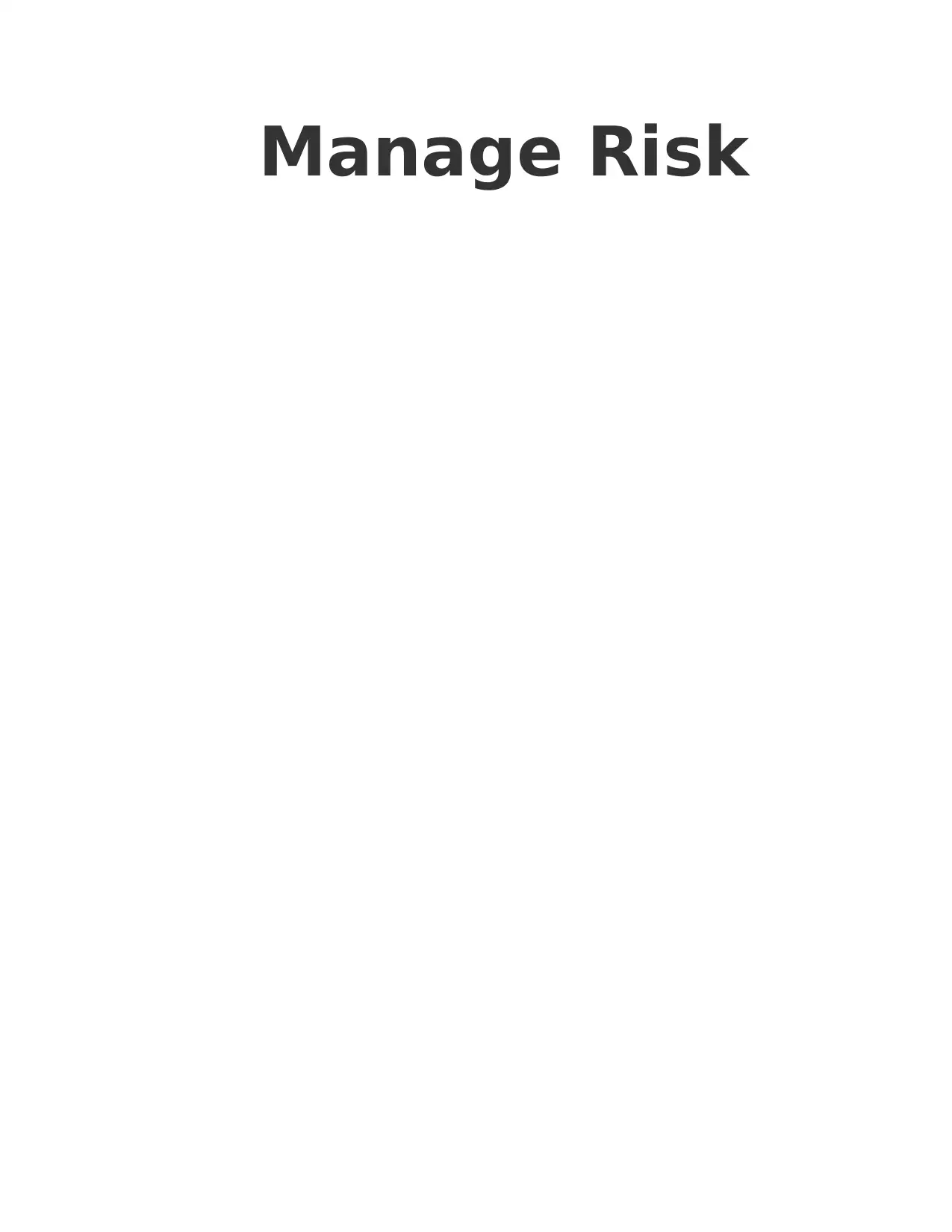
Manage Risk
Paraphrase This Document
Need a fresh take? Get an instant paraphrase of this document with our AI Paraphraser
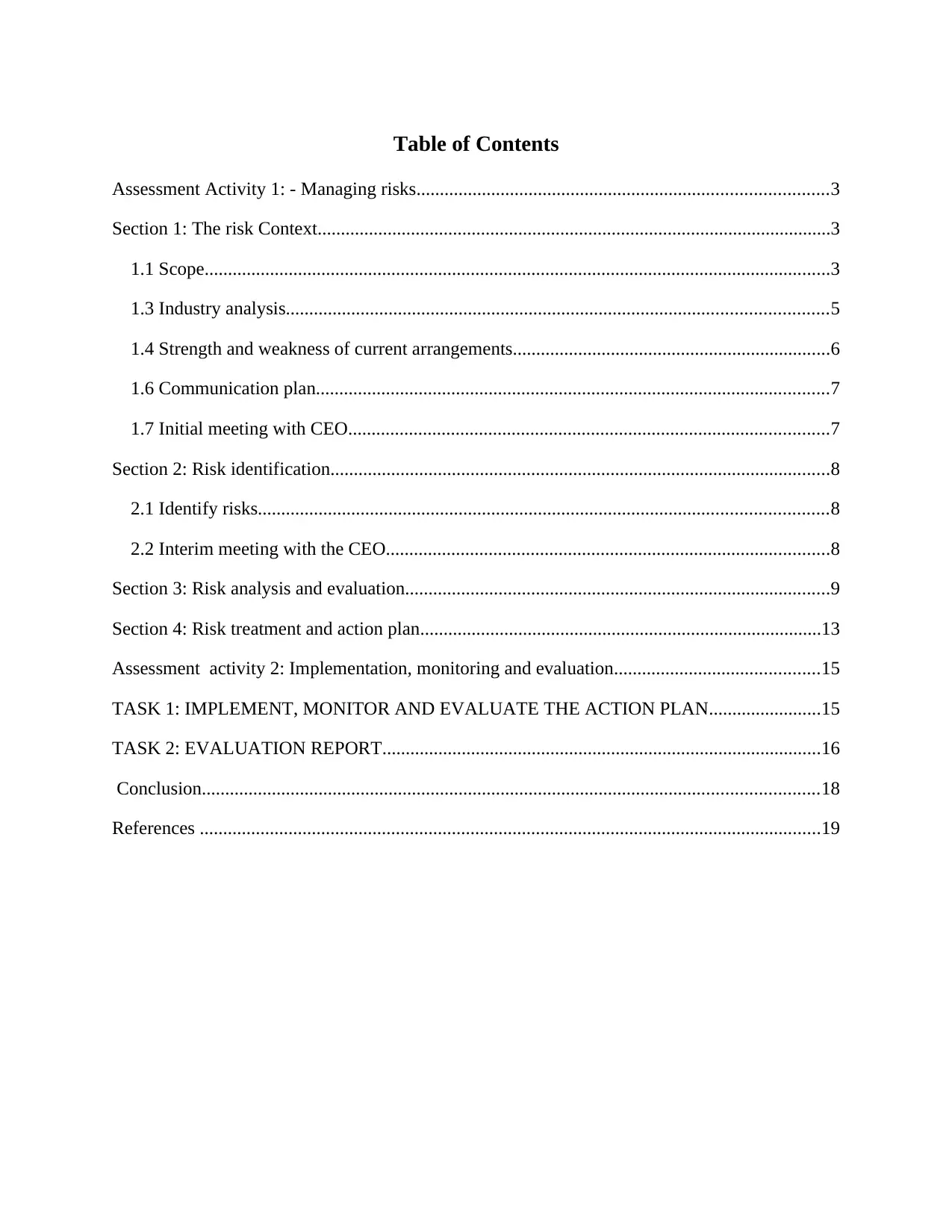
Table of Contents
Assessment Activity 1: - Managing risks........................................................................................3
Section 1: The risk Context..............................................................................................................3
1.1 Scope......................................................................................................................................3
1.3 Industry analysis....................................................................................................................5
1.4 Strength and weakness of current arrangements....................................................................6
1.6 Communication plan..............................................................................................................7
1.7 Initial meeting with CEO.......................................................................................................7
Section 2: Risk identification...........................................................................................................8
2.1 Identify risks..........................................................................................................................8
2.2 Interim meeting with the CEO...............................................................................................8
Section 3: Risk analysis and evaluation...........................................................................................9
Section 4: Risk treatment and action plan......................................................................................13
Assessment activity 2: Implementation, monitoring and evaluation............................................15
TASK 1: IMPLEMENT, MONITOR AND EVALUATE THE ACTION PLAN........................15
TASK 2: EVALUATION REPORT..............................................................................................16
Conclusion....................................................................................................................................18
References .....................................................................................................................................19
Assessment Activity 1: - Managing risks........................................................................................3
Section 1: The risk Context..............................................................................................................3
1.1 Scope......................................................................................................................................3
1.3 Industry analysis....................................................................................................................5
1.4 Strength and weakness of current arrangements....................................................................6
1.6 Communication plan..............................................................................................................7
1.7 Initial meeting with CEO.......................................................................................................7
Section 2: Risk identification...........................................................................................................8
2.1 Identify risks..........................................................................................................................8
2.2 Interim meeting with the CEO...............................................................................................8
Section 3: Risk analysis and evaluation...........................................................................................9
Section 4: Risk treatment and action plan......................................................................................13
Assessment activity 2: Implementation, monitoring and evaluation............................................15
TASK 1: IMPLEMENT, MONITOR AND EVALUATE THE ACTION PLAN........................15
TASK 2: EVALUATION REPORT..............................................................................................16
Conclusion....................................................................................................................................18
References .....................................................................................................................................19
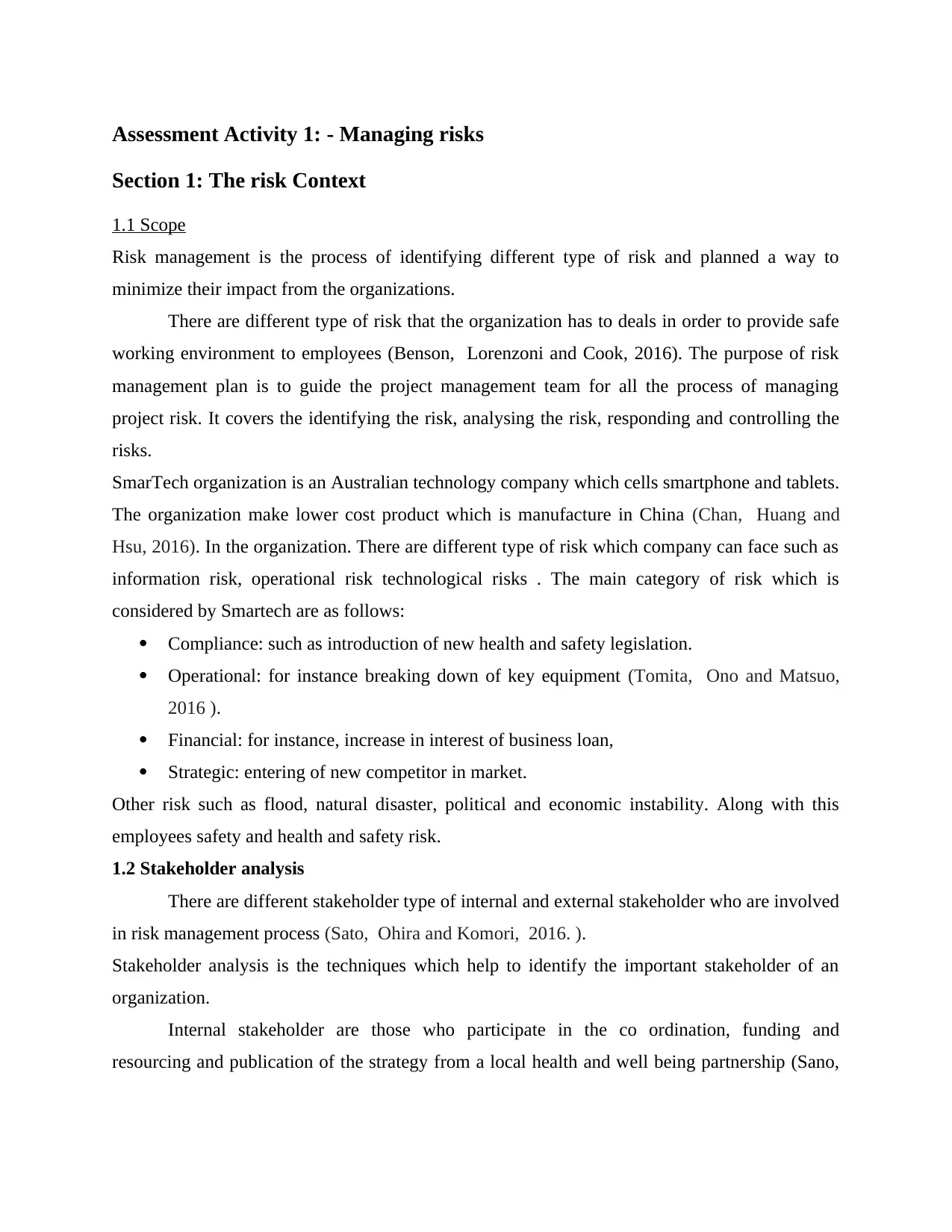
Assessment Activity 1: - Managing risks
Section 1: The risk Context
1.1 Scope
Risk management is the process of identifying different type of risk and planned a way to
minimize their impact from the organizations.
There are different type of risk that the organization has to deals in order to provide safe
working environment to employees (Benson, Lorenzoni and Cook, 2016). The purpose of risk
management plan is to guide the project management team for all the process of managing
project risk. It covers the identifying the risk, analysing the risk, responding and controlling the
risks.
SmarTech organization is an Australian technology company which cells smartphone and tablets.
The organization make lower cost product which is manufacture in China (Chan, Huang and
Hsu, 2016). In the organization. There are different type of risk which company can face such as
information risk, operational risk technological risks . The main category of risk which is
considered by Smartech are as follows:
Compliance: such as introduction of new health and safety legislation.
Operational: for instance breaking down of key equipment (Tomita, Ono and Matsuo,
2016 ).
Financial: for instance, increase in interest of business loan,
Strategic: entering of new competitor in market.
Other risk such as flood, natural disaster, political and economic instability. Along with this
employees safety and health and safety risk.
1.2 Stakeholder analysis
There are different stakeholder type of internal and external stakeholder who are involved
in risk management process (Sato, Ohira and Komori, 2016. ).
Stakeholder analysis is the techniques which help to identify the important stakeholder of an
organization.
Internal stakeholder are those who participate in the co ordination, funding and
resourcing and publication of the strategy from a local health and well being partnership (Sano,
Section 1: The risk Context
1.1 Scope
Risk management is the process of identifying different type of risk and planned a way to
minimize their impact from the organizations.
There are different type of risk that the organization has to deals in order to provide safe
working environment to employees (Benson, Lorenzoni and Cook, 2016). The purpose of risk
management plan is to guide the project management team for all the process of managing
project risk. It covers the identifying the risk, analysing the risk, responding and controlling the
risks.
SmarTech organization is an Australian technology company which cells smartphone and tablets.
The organization make lower cost product which is manufacture in China (Chan, Huang and
Hsu, 2016). In the organization. There are different type of risk which company can face such as
information risk, operational risk technological risks . The main category of risk which is
considered by Smartech are as follows:
Compliance: such as introduction of new health and safety legislation.
Operational: for instance breaking down of key equipment (Tomita, Ono and Matsuo,
2016 ).
Financial: for instance, increase in interest of business loan,
Strategic: entering of new competitor in market.
Other risk such as flood, natural disaster, political and economic instability. Along with this
employees safety and health and safety risk.
1.2 Stakeholder analysis
There are different stakeholder type of internal and external stakeholder who are involved
in risk management process (Sato, Ohira and Komori, 2016. ).
Stakeholder analysis is the techniques which help to identify the important stakeholder of an
organization.
Internal stakeholder are those who participate in the co ordination, funding and
resourcing and publication of the strategy from a local health and well being partnership (Sano,
⊘ This is a preview!⊘
Do you want full access?
Subscribe today to unlock all pages.

Trusted by 1+ million students worldwide
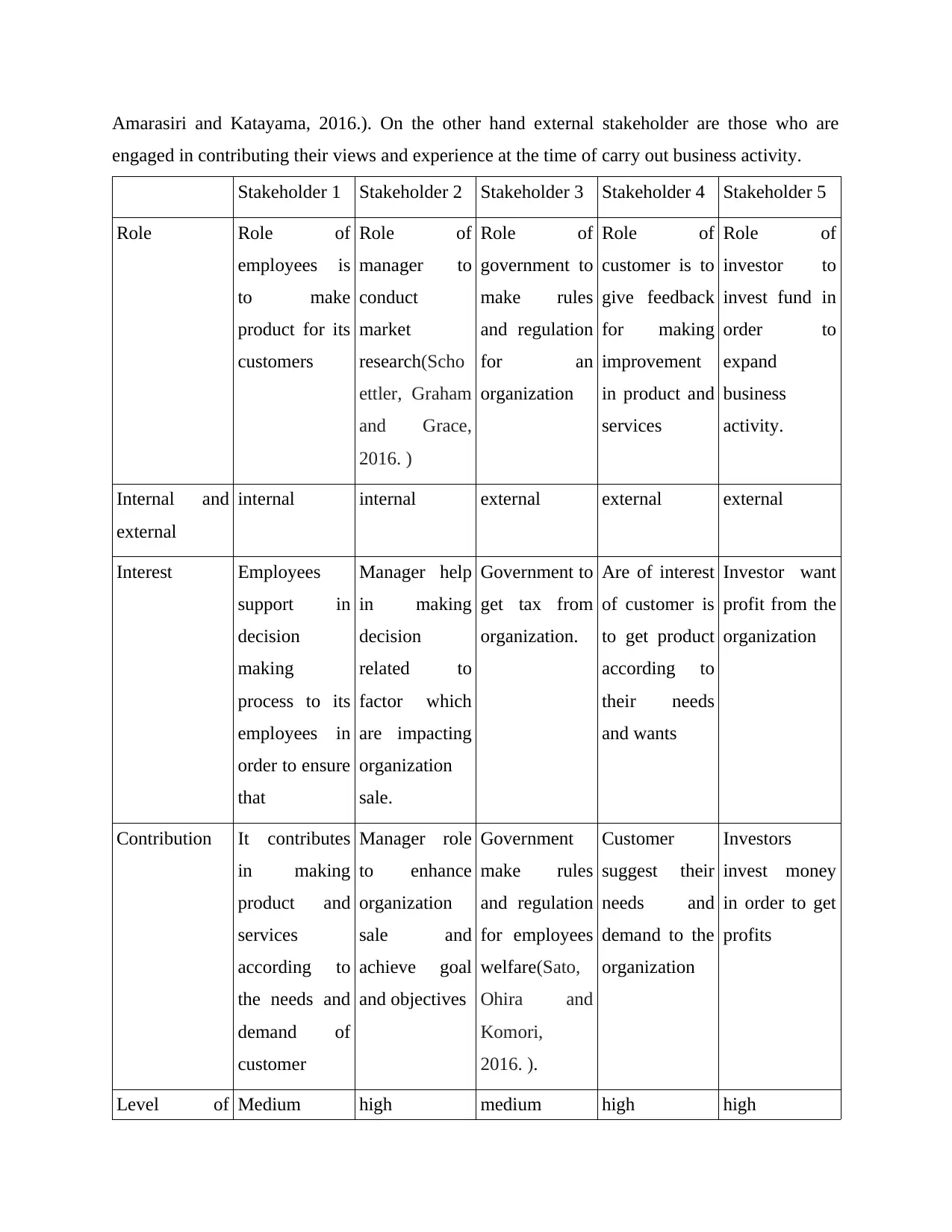
Amarasiri and Katayama, 2016.). On the other hand external stakeholder are those who are
engaged in contributing their views and experience at the time of carry out business activity.
Stakeholder 1 Stakeholder 2 Stakeholder 3 Stakeholder 4 Stakeholder 5
Role Role of
employees is
to make
product for its
customers
Role of
manager to
conduct
market
research(Scho
ettler, Graham
and Grace,
2016. )
Role of
government to
make rules
and regulation
for an
organization
Role of
customer is to
give feedback
for making
improvement
in product and
services
Role of
investor to
invest fund in
order to
expand
business
activity.
Internal and
external
internal internal external external external
Interest Employees
support in
decision
making
process to its
employees in
order to ensure
that
Manager help
in making
decision
related to
factor which
are impacting
organization
sale.
Government to
get tax from
organization.
Are of interest
of customer is
to get product
according to
their needs
and wants
Investor want
profit from the
organization
Contribution It contributes
in making
product and
services
according to
the needs and
demand of
customer
Manager role
to enhance
organization
sale and
achieve goal
and objectives
Government
make rules
and regulation
for employees
welfare(Sato,
Ohira and
Komori,
2016. ).
Customer
suggest their
needs and
demand to the
organization
Investors
invest money
in order to get
profits
Level of Medium high medium high high
engaged in contributing their views and experience at the time of carry out business activity.
Stakeholder 1 Stakeholder 2 Stakeholder 3 Stakeholder 4 Stakeholder 5
Role Role of
employees is
to make
product for its
customers
Role of
manager to
conduct
market
research(Scho
ettler, Graham
and Grace,
2016. )
Role of
government to
make rules
and regulation
for an
organization
Role of
customer is to
give feedback
for making
improvement
in product and
services
Role of
investor to
invest fund in
order to
expand
business
activity.
Internal and
external
internal internal external external external
Interest Employees
support in
decision
making
process to its
employees in
order to ensure
that
Manager help
in making
decision
related to
factor which
are impacting
organization
sale.
Government to
get tax from
organization.
Are of interest
of customer is
to get product
according to
their needs
and wants
Investor want
profit from the
organization
Contribution It contributes
in making
product and
services
according to
the needs and
demand of
customer
Manager role
to enhance
organization
sale and
achieve goal
and objectives
Government
make rules
and regulation
for employees
welfare(Sato,
Ohira and
Komori,
2016. ).
Customer
suggest their
needs and
demand to the
organization
Investors
invest money
in order to get
profits
Level of Medium high medium high high
Paraphrase This Document
Need a fresh take? Get an instant paraphrase of this document with our AI Paraphraser
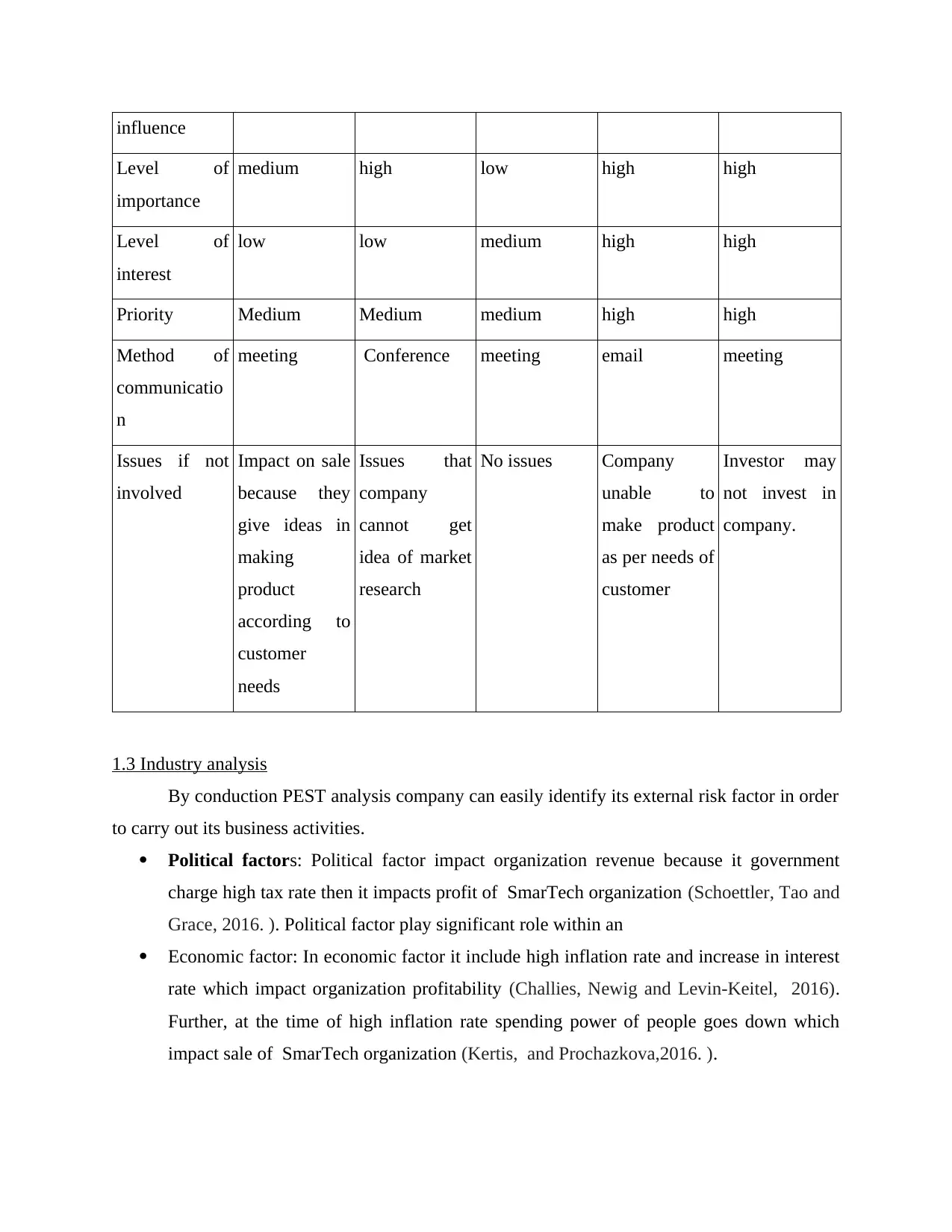
influence
Level of
importance
medium high low high high
Level of
interest
low low medium high high
Priority Medium Medium medium high high
Method of
communicatio
n
meeting Conference meeting email meeting
Issues if not
involved
Impact on sale
because they
give ideas in
making
product
according to
customer
needs
Issues that
company
cannot get
idea of market
research
No issues Company
unable to
make product
as per needs of
customer
Investor may
not invest in
company.
1.3 Industry analysis
By conduction PEST analysis company can easily identify its external risk factor in order
to carry out its business activities.
Political factors: Political factor impact organization revenue because it government
charge high tax rate then it impacts profit of SmarTech organization (Schoettler, Tao and
Grace, 2016. ). Political factor play significant role within an
Economic factor: In economic factor it include high inflation rate and increase in interest
rate which impact organization profitability (Challies, Newig and Levin-Keitel, 2016).
Further, at the time of high inflation rate spending power of people goes down which
impact sale of SmarTech organization (Kertis, and Prochazkova,2016. ).
Level of
importance
medium high low high high
Level of
interest
low low medium high high
Priority Medium Medium medium high high
Method of
communicatio
n
meeting Conference meeting email meeting
Issues if not
involved
Impact on sale
because they
give ideas in
making
product
according to
customer
needs
Issues that
company
cannot get
idea of market
research
No issues Company
unable to
make product
as per needs of
customer
Investor may
not invest in
company.
1.3 Industry analysis
By conduction PEST analysis company can easily identify its external risk factor in order
to carry out its business activities.
Political factors: Political factor impact organization revenue because it government
charge high tax rate then it impacts profit of SmarTech organization (Schoettler, Tao and
Grace, 2016. ). Political factor play significant role within an
Economic factor: In economic factor it include high inflation rate and increase in interest
rate which impact organization profitability (Challies, Newig and Levin-Keitel, 2016).
Further, at the time of high inflation rate spending power of people goes down which
impact sale of SmarTech organization (Kertis, and Prochazkova,2016. ).
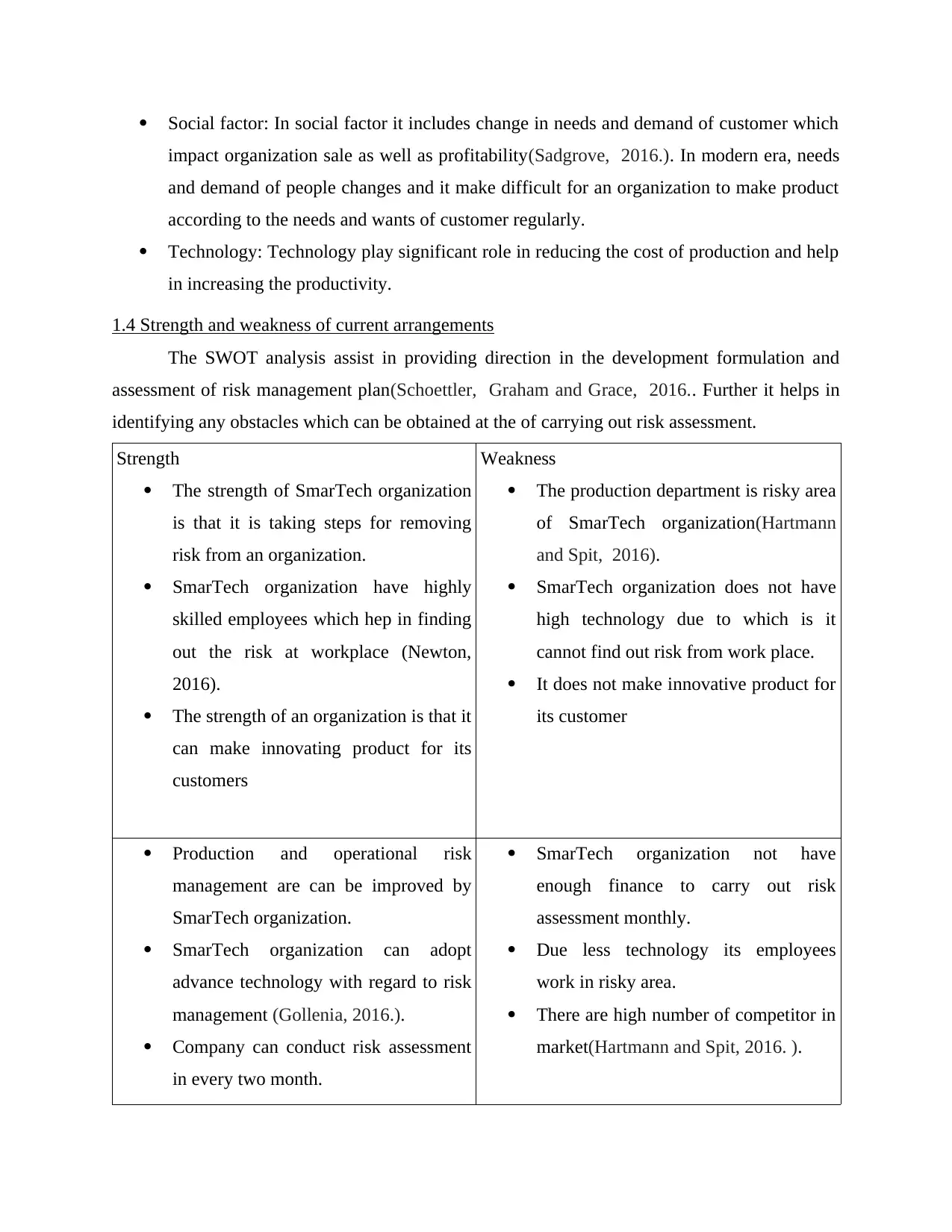
Social factor: In social factor it includes change in needs and demand of customer which
impact organization sale as well as profitability(Sadgrove, 2016.). In modern era, needs
and demand of people changes and it make difficult for an organization to make product
according to the needs and wants of customer regularly.
Technology: Technology play significant role in reducing the cost of production and help
in increasing the productivity.
1.4 Strength and weakness of current arrangements
The SWOT analysis assist in providing direction in the development formulation and
assessment of risk management plan(Schoettler, Graham and Grace, 2016.. Further it helps in
identifying any obstacles which can be obtained at the of carrying out risk assessment.
Strength
The strength of SmarTech organization
is that it is taking steps for removing
risk from an organization.
SmarTech organization have highly
skilled employees which hep in finding
out the risk at workplace (Newton,
2016).
The strength of an organization is that it
can make innovating product for its
customers
Weakness
The production department is risky area
of SmarTech organization(Hartmann
and Spit, 2016).
SmarTech organization does not have
high technology due to which is it
cannot find out risk from work place.
It does not make innovative product for
its customer
Production and operational risk
management are can be improved by
SmarTech organization.
SmarTech organization can adopt
advance technology with regard to risk
management (Gollenia, 2016.).
Company can conduct risk assessment
in every two month.
SmarTech organization not have
enough finance to carry out risk
assessment monthly.
Due less technology its employees
work in risky area.
There are high number of competitor in
market(Hartmann and Spit, 2016. ).
impact organization sale as well as profitability(Sadgrove, 2016.). In modern era, needs
and demand of people changes and it make difficult for an organization to make product
according to the needs and wants of customer regularly.
Technology: Technology play significant role in reducing the cost of production and help
in increasing the productivity.
1.4 Strength and weakness of current arrangements
The SWOT analysis assist in providing direction in the development formulation and
assessment of risk management plan(Schoettler, Graham and Grace, 2016.. Further it helps in
identifying any obstacles which can be obtained at the of carrying out risk assessment.
Strength
The strength of SmarTech organization
is that it is taking steps for removing
risk from an organization.
SmarTech organization have highly
skilled employees which hep in finding
out the risk at workplace (Newton,
2016).
The strength of an organization is that it
can make innovating product for its
customers
Weakness
The production department is risky area
of SmarTech organization(Hartmann
and Spit, 2016).
SmarTech organization does not have
high technology due to which is it
cannot find out risk from work place.
It does not make innovative product for
its customer
Production and operational risk
management are can be improved by
SmarTech organization.
SmarTech organization can adopt
advance technology with regard to risk
management (Gollenia, 2016.).
Company can conduct risk assessment
in every two month.
SmarTech organization not have
enough finance to carry out risk
assessment monthly.
Due less technology its employees
work in risky area.
There are high number of competitor in
market(Hartmann and Spit, 2016. ).
⊘ This is a preview!⊘
Do you want full access?
Subscribe today to unlock all pages.

Trusted by 1+ million students worldwide
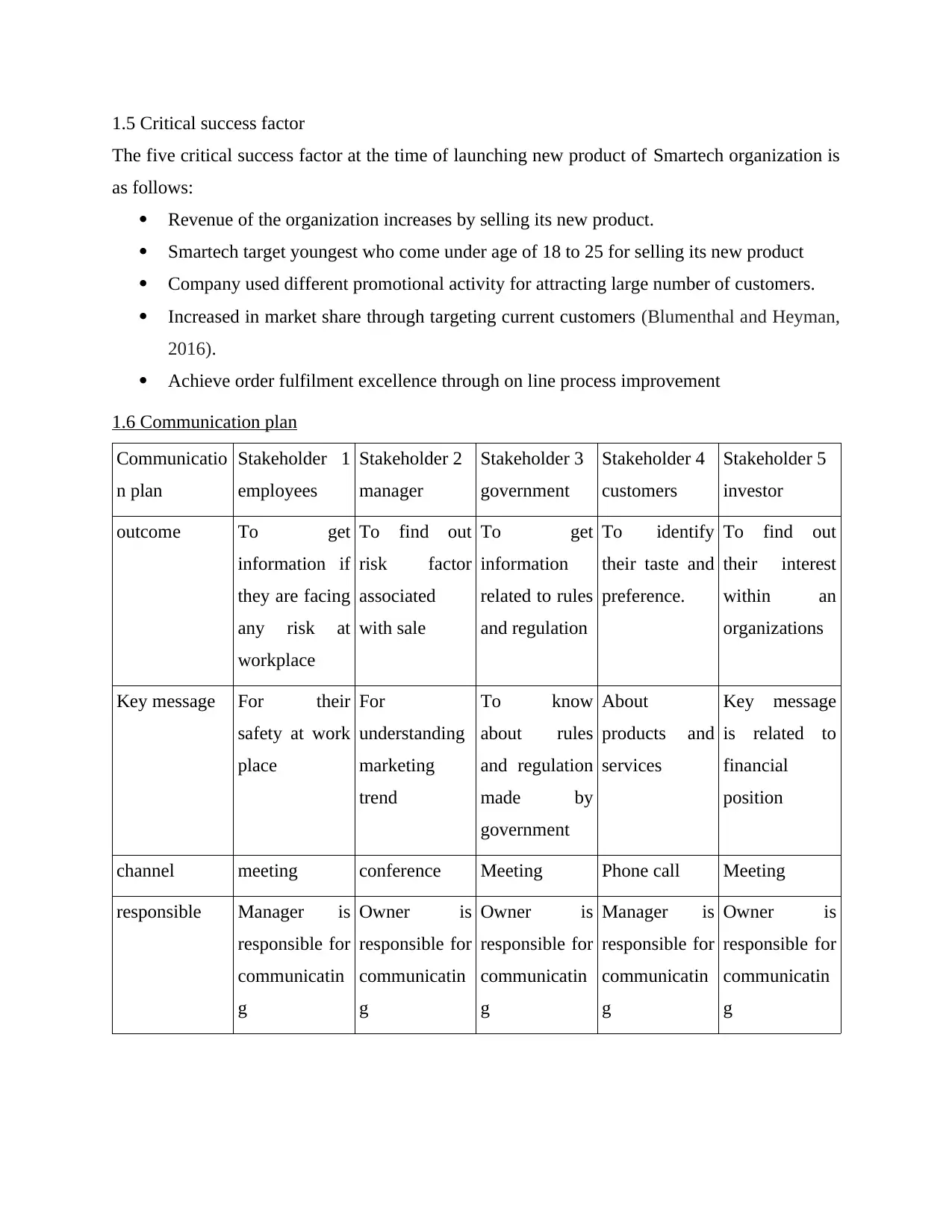
1.5 Critical success factor
The five critical success factor at the time of launching new product of Smartech organization is
as follows:
Revenue of the organization increases by selling its new product.
Smartech target youngest who come under age of 18 to 25 for selling its new product
Company used different promotional activity for attracting large number of customers.
Increased in market share through targeting current customers (Blumenthal and Heyman,
2016).
Achieve order fulfilment excellence through on line process improvement
1.6 Communication plan
Communicatio
n plan
Stakeholder 1
employees
Stakeholder 2
manager
Stakeholder 3
government
Stakeholder 4
customers
Stakeholder 5
investor
outcome To get
information if
they are facing
any risk at
workplace
To find out
risk factor
associated
with sale
To get
information
related to rules
and regulation
To identify
their taste and
preference.
To find out
their interest
within an
organizations
Key message For their
safety at work
place
For
understanding
marketing
trend
To know
about rules
and regulation
made by
government
About
products and
services
Key message
is related to
financial
position
channel meeting conference Meeting Phone call Meeting
responsible Manager is
responsible for
communicatin
g
Owner is
responsible for
communicatin
g
Owner is
responsible for
communicatin
g
Manager is
responsible for
communicatin
g
Owner is
responsible for
communicatin
g
The five critical success factor at the time of launching new product of Smartech organization is
as follows:
Revenue of the organization increases by selling its new product.
Smartech target youngest who come under age of 18 to 25 for selling its new product
Company used different promotional activity for attracting large number of customers.
Increased in market share through targeting current customers (Blumenthal and Heyman,
2016).
Achieve order fulfilment excellence through on line process improvement
1.6 Communication plan
Communicatio
n plan
Stakeholder 1
employees
Stakeholder 2
manager
Stakeholder 3
government
Stakeholder 4
customers
Stakeholder 5
investor
outcome To get
information if
they are facing
any risk at
workplace
To find out
risk factor
associated
with sale
To get
information
related to rules
and regulation
To identify
their taste and
preference.
To find out
their interest
within an
organizations
Key message For their
safety at work
place
For
understanding
marketing
trend
To know
about rules
and regulation
made by
government
About
products and
services
Key message
is related to
financial
position
channel meeting conference Meeting Phone call Meeting
responsible Manager is
responsible for
communicatin
g
Owner is
responsible for
communicatin
g
Owner is
responsible for
communicatin
g
Manager is
responsible for
communicatin
g
Owner is
responsible for
communicatin
g
Paraphrase This Document
Need a fresh take? Get an instant paraphrase of this document with our AI Paraphraser
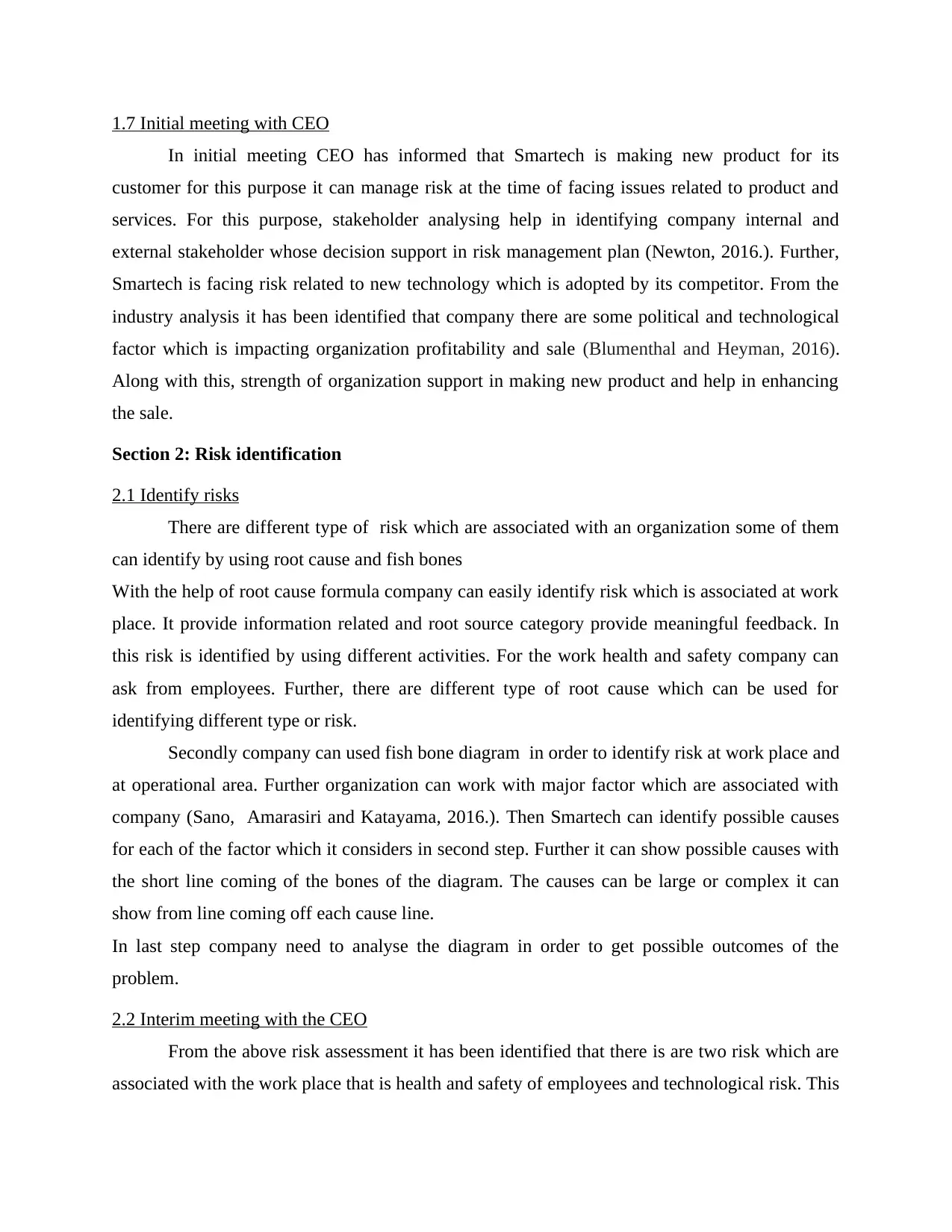
1.7 Initial meeting with CEO
In initial meeting CEO has informed that Smartech is making new product for its
customer for this purpose it can manage risk at the time of facing issues related to product and
services. For this purpose, stakeholder analysing help in identifying company internal and
external stakeholder whose decision support in risk management plan (Newton, 2016.). Further,
Smartech is facing risk related to new technology which is adopted by its competitor. From the
industry analysis it has been identified that company there are some political and technological
factor which is impacting organization profitability and sale (Blumenthal and Heyman, 2016).
Along with this, strength of organization support in making new product and help in enhancing
the sale.
Section 2: Risk identification
2.1 Identify risks
There are different type of risk which are associated with an organization some of them
can identify by using root cause and fish bones
With the help of root cause formula company can easily identify risk which is associated at work
place. It provide information related and root source category provide meaningful feedback. In
this risk is identified by using different activities. For the work health and safety company can
ask from employees. Further, there are different type of root cause which can be used for
identifying different type or risk.
Secondly company can used fish bone diagram in order to identify risk at work place and
at operational area. Further organization can work with major factor which are associated with
company (Sano, Amarasiri and Katayama, 2016.). Then Smartech can identify possible causes
for each of the factor which it considers in second step. Further it can show possible causes with
the short line coming of the bones of the diagram. The causes can be large or complex it can
show from line coming off each cause line.
In last step company need to analyse the diagram in order to get possible outcomes of the
problem.
2.2 Interim meeting with the CEO
From the above risk assessment it has been identified that there is are two risk which are
associated with the work place that is health and safety of employees and technological risk. This
In initial meeting CEO has informed that Smartech is making new product for its
customer for this purpose it can manage risk at the time of facing issues related to product and
services. For this purpose, stakeholder analysing help in identifying company internal and
external stakeholder whose decision support in risk management plan (Newton, 2016.). Further,
Smartech is facing risk related to new technology which is adopted by its competitor. From the
industry analysis it has been identified that company there are some political and technological
factor which is impacting organization profitability and sale (Blumenthal and Heyman, 2016).
Along with this, strength of organization support in making new product and help in enhancing
the sale.
Section 2: Risk identification
2.1 Identify risks
There are different type of risk which are associated with an organization some of them
can identify by using root cause and fish bones
With the help of root cause formula company can easily identify risk which is associated at work
place. It provide information related and root source category provide meaningful feedback. In
this risk is identified by using different activities. For the work health and safety company can
ask from employees. Further, there are different type of root cause which can be used for
identifying different type or risk.
Secondly company can used fish bone diagram in order to identify risk at work place and
at operational area. Further organization can work with major factor which are associated with
company (Sano, Amarasiri and Katayama, 2016.). Then Smartech can identify possible causes
for each of the factor which it considers in second step. Further it can show possible causes with
the short line coming of the bones of the diagram. The causes can be large or complex it can
show from line coming off each cause line.
In last step company need to analyse the diagram in order to get possible outcomes of the
problem.
2.2 Interim meeting with the CEO
From the above risk assessment it has been identified that there is are two risk which are
associated with the work place that is health and safety of employees and technological risk. This
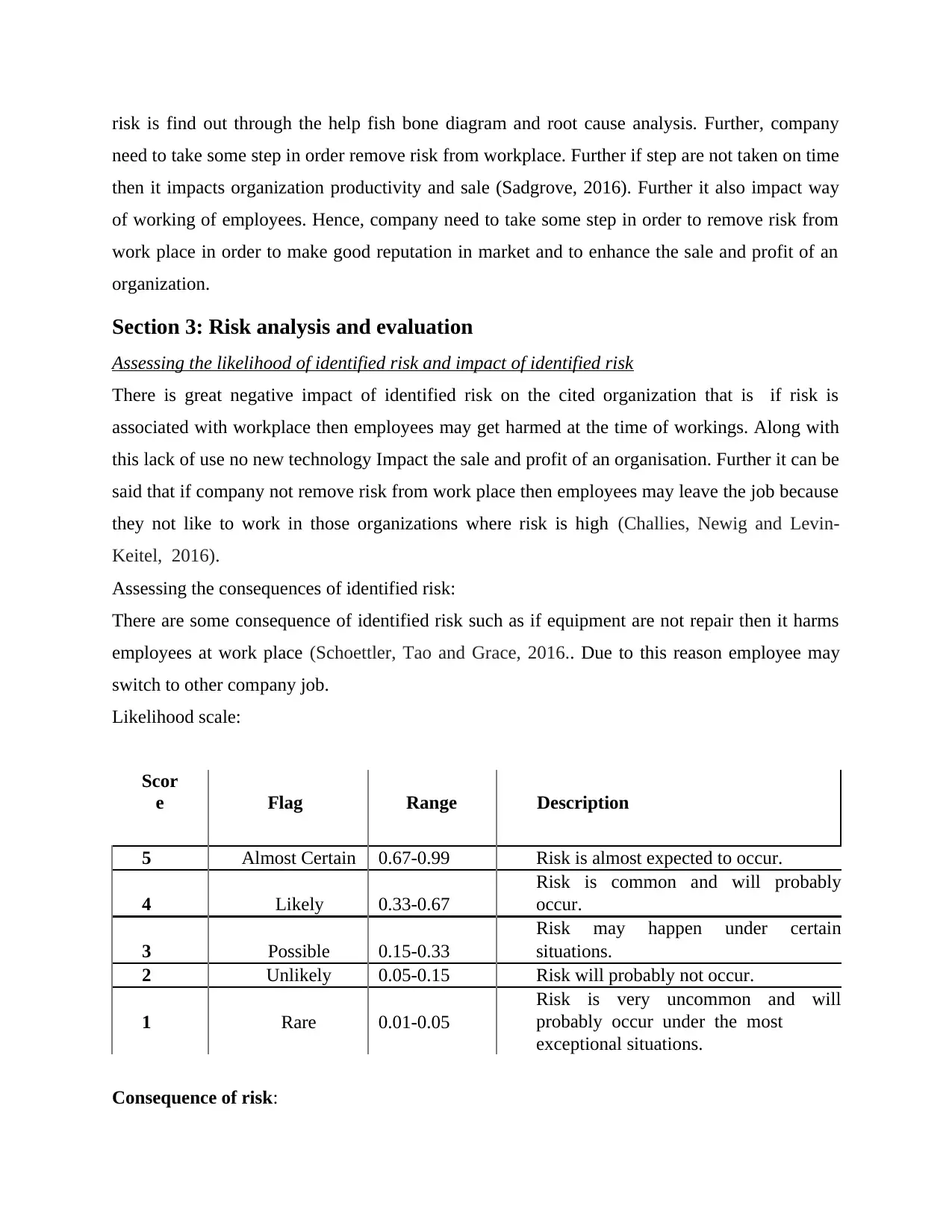
risk is find out through the help fish bone diagram and root cause analysis. Further, company
need to take some step in order remove risk from workplace. Further if step are not taken on time
then it impacts organization productivity and sale (Sadgrove, 2016). Further it also impact way
of working of employees. Hence, company need to take some step in order to remove risk from
work place in order to make good reputation in market and to enhance the sale and profit of an
organization.
Section 3: Risk analysis and evaluation
Assessing the likelihood of identified risk and impact of identified risk
There is great negative impact of identified risk on the cited organization that is if risk is
associated with workplace then employees may get harmed at the time of workings. Along with
this lack of use no new technology Impact the sale and profit of an organisation. Further it can be
said that if company not remove risk from work place then employees may leave the job because
they not like to work in those organizations where risk is high (Challies, Newig and Levin-
Keitel, 2016).
Assessing the consequences of identified risk:
There are some consequence of identified risk such as if equipment are not repair then it harms
employees at work place (Schoettler, Tao and Grace, 2016.. Due to this reason employee may
switch to other company job.
Likelihood scale:
Scor
e Flag Range Description
5 Almost Certain 0.67-0.99 Risk is almost expected to occur.
4 Likely 0.33-0.67
Risk is common and will probably
occur.
3 Possible 0.15-0.33
Risk may happen under certain
situations.
2 Unlikely 0.05-0.15 Risk will probably not occur.
1 Rare 0.01-0.05
Risk is very uncommon and will
probably occur under the most
exceptional situations.
Consequence of risk:
need to take some step in order remove risk from workplace. Further if step are not taken on time
then it impacts organization productivity and sale (Sadgrove, 2016). Further it also impact way
of working of employees. Hence, company need to take some step in order to remove risk from
work place in order to make good reputation in market and to enhance the sale and profit of an
organization.
Section 3: Risk analysis and evaluation
Assessing the likelihood of identified risk and impact of identified risk
There is great negative impact of identified risk on the cited organization that is if risk is
associated with workplace then employees may get harmed at the time of workings. Along with
this lack of use no new technology Impact the sale and profit of an organisation. Further it can be
said that if company not remove risk from work place then employees may leave the job because
they not like to work in those organizations where risk is high (Challies, Newig and Levin-
Keitel, 2016).
Assessing the consequences of identified risk:
There are some consequence of identified risk such as if equipment are not repair then it harms
employees at work place (Schoettler, Tao and Grace, 2016.. Due to this reason employee may
switch to other company job.
Likelihood scale:
Scor
e Flag Range Description
5 Almost Certain 0.67-0.99 Risk is almost expected to occur.
4 Likely 0.33-0.67
Risk is common and will probably
occur.
3 Possible 0.15-0.33
Risk may happen under certain
situations.
2 Unlikely 0.05-0.15 Risk will probably not occur.
1 Rare 0.01-0.05
Risk is very uncommon and will
probably occur under the most
exceptional situations.
Consequence of risk:
⊘ This is a preview!⊘
Do you want full access?
Subscribe today to unlock all pages.

Trusted by 1+ million students worldwide
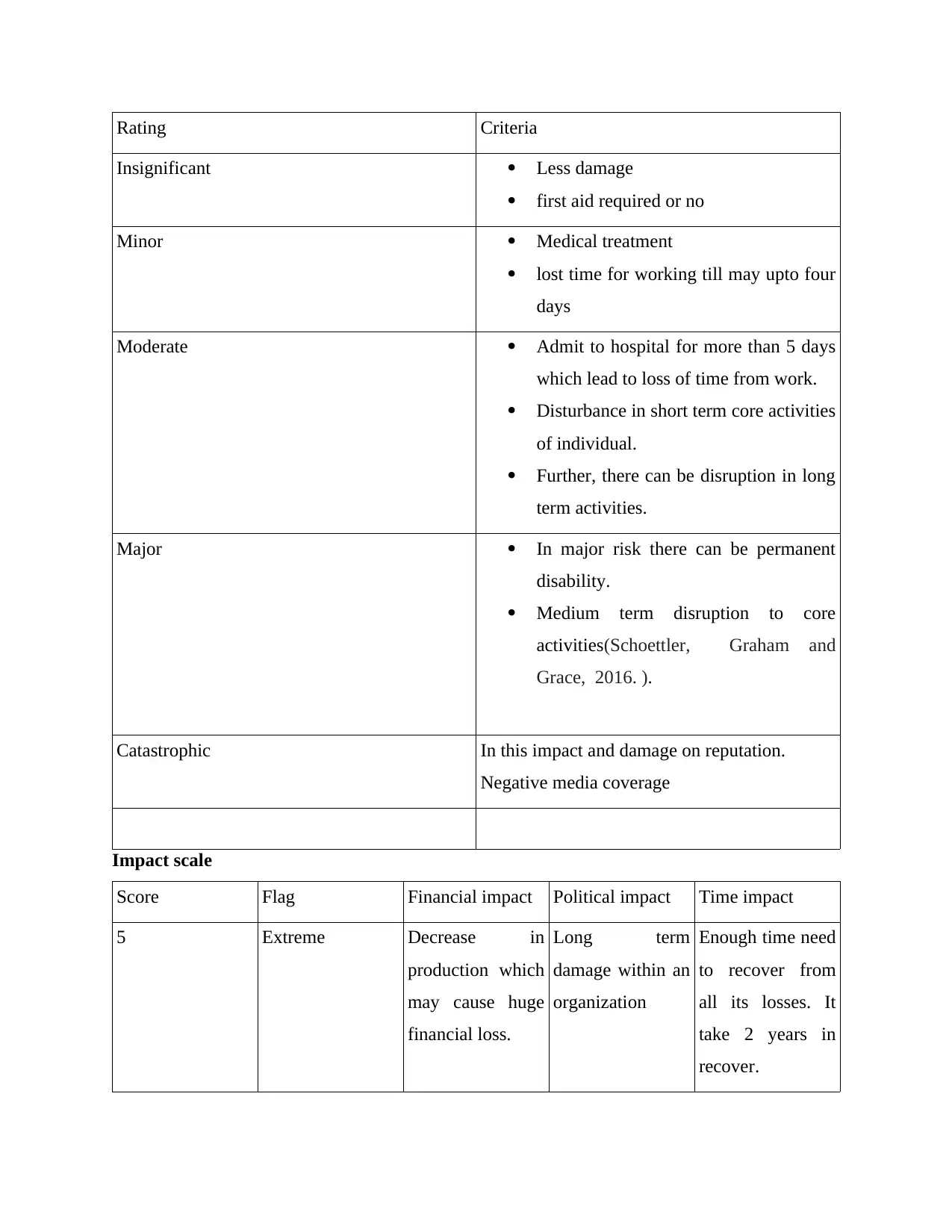
Rating Criteria
Insignificant Less damage
first aid required or no
Minor Medical treatment
lost time for working till may upto four
days
Moderate Admit to hospital for more than 5 days
which lead to loss of time from work.
Disturbance in short term core activities
of individual.
Further, there can be disruption in long
term activities.
Major In major risk there can be permanent
disability.
Medium term disruption to core
activities(Schoettler, Graham and
Grace, 2016. ).
Catastrophic In this impact and damage on reputation.
Negative media coverage
Impact scale
Score Flag Financial impact Political impact Time impact
5 Extreme Decrease in
production which
may cause huge
financial loss.
Long term
damage within an
organization
Enough time need
to recover from
all its losses. It
take 2 years in
recover.
Insignificant Less damage
first aid required or no
Minor Medical treatment
lost time for working till may upto four
days
Moderate Admit to hospital for more than 5 days
which lead to loss of time from work.
Disturbance in short term core activities
of individual.
Further, there can be disruption in long
term activities.
Major In major risk there can be permanent
disability.
Medium term disruption to core
activities(Schoettler, Graham and
Grace, 2016. ).
Catastrophic In this impact and damage on reputation.
Negative media coverage
Impact scale
Score Flag Financial impact Political impact Time impact
5 Extreme Decrease in
production which
may cause huge
financial loss.
Long term
damage within an
organization
Enough time need
to recover from
all its losses. It
take 2 years in
recover.
Paraphrase This Document
Need a fresh take? Get an instant paraphrase of this document with our AI Paraphraser
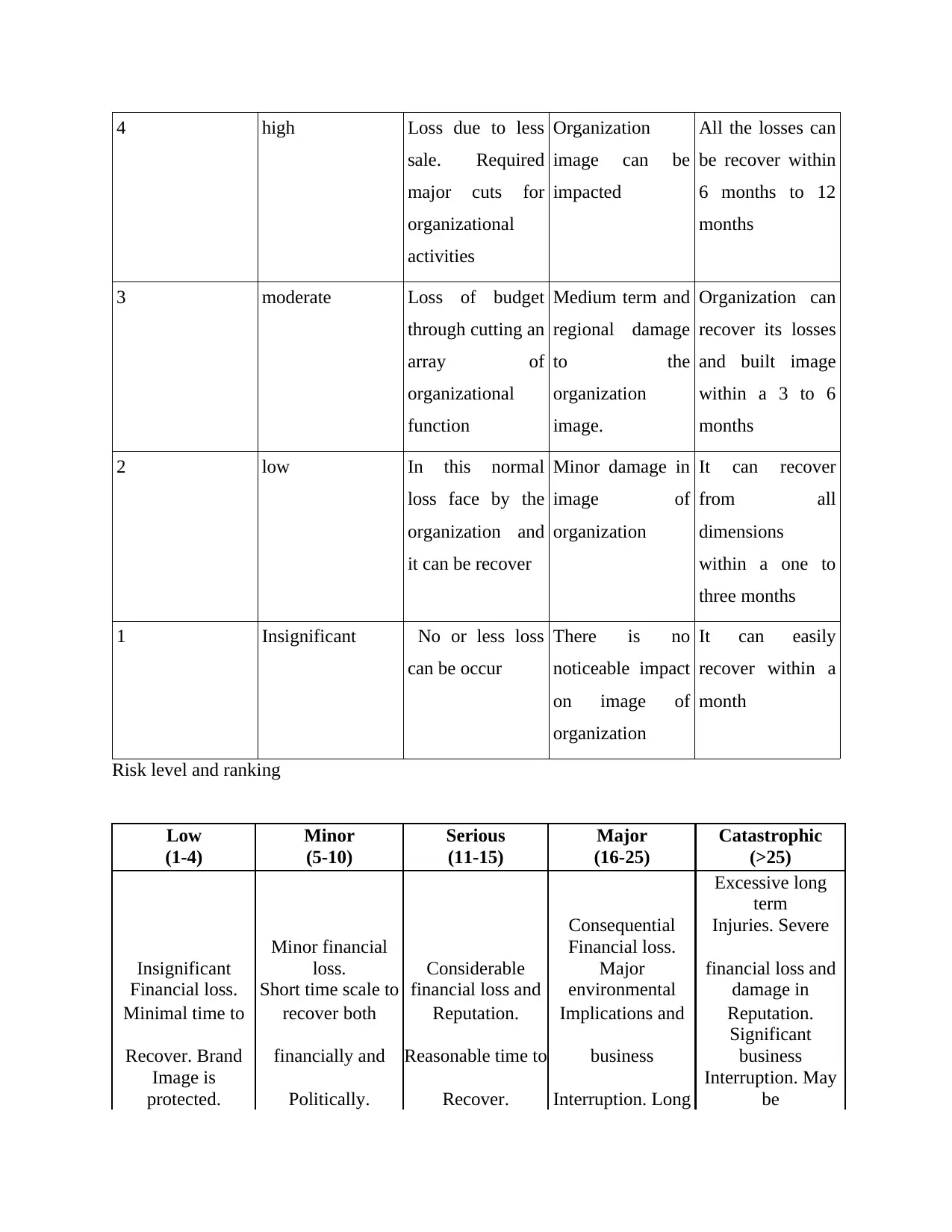
4 high Loss due to less
sale. Required
major cuts for
organizational
activities
Organization
image can be
impacted
All the losses can
be recover within
6 months to 12
months
3 moderate Loss of budget
through cutting an
array of
organizational
function
Medium term and
regional damage
to the
organization
image.
Organization can
recover its losses
and built image
within a 3 to 6
months
2 low In this normal
loss face by the
organization and
it can be recover
Minor damage in
image of
organization
It can recover
from all
dimensions
within a one to
three months
1 Insignificant No or less loss
can be occur
There is no
noticeable impact
on image of
organization
It can easily
recover within a
month
Risk level and ranking
Low Minor Serious Major Catastrophic
(1-4) (5-10) (11-15) (16-25) (>25)
Excessive long
term
Consequential Injuries. Severe
Insignificant
Minor financial
loss. Considerable
Financial loss.
Major financial loss and
Financial loss. Short time scale to financial loss and environmental damage in
Minimal time to recover both Reputation. Implications and Reputation.
Recover. Brand financially and Reasonable time to business
Significant
business
Image is
protected. Politically. Recover. Interruption. Long
Interruption. May
be
sale. Required
major cuts for
organizational
activities
Organization
image can be
impacted
All the losses can
be recover within
6 months to 12
months
3 moderate Loss of budget
through cutting an
array of
organizational
function
Medium term and
regional damage
to the
organization
image.
Organization can
recover its losses
and built image
within a 3 to 6
months
2 low In this normal
loss face by the
organization and
it can be recover
Minor damage in
image of
organization
It can recover
from all
dimensions
within a one to
three months
1 Insignificant No or less loss
can be occur
There is no
noticeable impact
on image of
organization
It can easily
recover within a
month
Risk level and ranking
Low Minor Serious Major Catastrophic
(1-4) (5-10) (11-15) (16-25) (>25)
Excessive long
term
Consequential Injuries. Severe
Insignificant
Minor financial
loss. Considerable
Financial loss.
Major financial loss and
Financial loss. Short time scale to financial loss and environmental damage in
Minimal time to recover both Reputation. Implications and Reputation.
Recover. Brand financially and Reasonable time to business
Significant
business
Image is
protected. Politically. Recover. Interruption. Long
Interruption. May
be
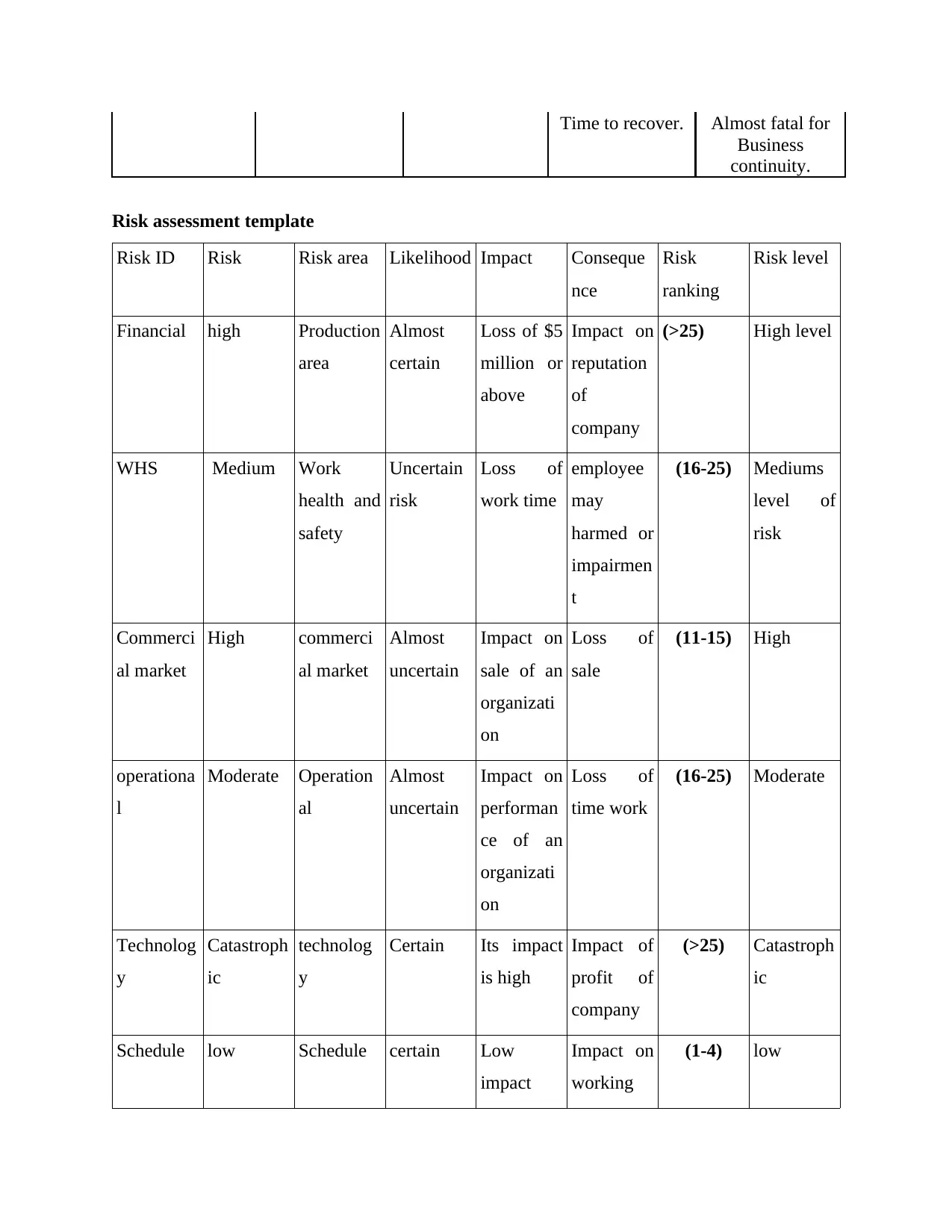
Time to recover. Almost fatal for
Business
continuity.
Risk assessment template
Risk ID Risk Risk area Likelihood Impact Conseque
nce
Risk
ranking
Risk level
Financial high Production
area
Almost
certain
Loss of $5
million or
above
Impact on
reputation
of
company
(>25) High level
WHS Medium Work
health and
safety
Uncertain
risk
Loss of
work time
employee
may
harmed or
impairmen
t
(16-25) Mediums
level of
risk
Commerci
al market
High commerci
al market
Almost
uncertain
Impact on
sale of an
organizati
on
Loss of
sale
(11-15) High
operationa
l
Moderate Operation
al
Almost
uncertain
Impact on
performan
ce of an
organizati
on
Loss of
time work
(16-25) Moderate
Technolog
y
Catastroph
ic
technolog
y
Certain Its impact
is high
Impact of
profit of
company
(>25) Catastroph
ic
Schedule low Schedule certain Low
impact
Impact on
working
(1-4) low
Business
continuity.
Risk assessment template
Risk ID Risk Risk area Likelihood Impact Conseque
nce
Risk
ranking
Risk level
Financial high Production
area
Almost
certain
Loss of $5
million or
above
Impact on
reputation
of
company
(>25) High level
WHS Medium Work
health and
safety
Uncertain
risk
Loss of
work time
employee
may
harmed or
impairmen
t
(16-25) Mediums
level of
risk
Commerci
al market
High commerci
al market
Almost
uncertain
Impact on
sale of an
organizati
on
Loss of
sale
(11-15) High
operationa
l
Moderate Operation
al
Almost
uncertain
Impact on
performan
ce of an
organizati
on
Loss of
time work
(16-25) Moderate
Technolog
y
Catastroph
ic
technolog
y
Certain Its impact
is high
Impact of
profit of
company
(>25) Catastroph
ic
Schedule low Schedule certain Low
impact
Impact on
working
(1-4) low
⊘ This is a preview!⊘
Do you want full access?
Subscribe today to unlock all pages.

Trusted by 1+ million students worldwide
1 out of 21
Related Documents
Your All-in-One AI-Powered Toolkit for Academic Success.
+13062052269
info@desklib.com
Available 24*7 on WhatsApp / Email
![[object Object]](/_next/static/media/star-bottom.7253800d.svg)
Unlock your academic potential
Copyright © 2020–2025 A2Z Services. All Rights Reserved. Developed and managed by ZUCOL.





